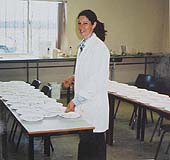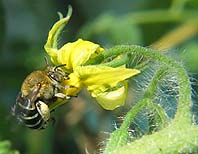Home
Aussie Bee Online
Welcome
New Articles
About Native Bees
Bee Photo Gallery
Bees in Your Area
Common Questions
Rescuing Native Bees
Exotic Bumblebees
What are Stingless Bees?
Buying Stingless Bees
Honey Production
Crop Pollination
Study Native Bees
Field Guide
Information Booklets
Tim Heard's Book
John Klumpp's Book
Aussie Bee Back Issues
Seminars
Links
Support Native Bees
Aussie Bee Shop
Order Form
Who We Are
Donations
Privacy Policy
Free Newsletter
Website Survey
Download Printer-Friendly PDF version of this article
Tomato Pollination With Blue Banded Bees
Dr Anne Dollin
Australian Native Bee Research Centre
April 2006
Melissa Bell's research at the University of Western Sydney - Hawkesbury has now shown that native blue banded bees (Amegilla) can be efficient pollinators of greenhouse tomatoes.
Australian greenhouse tomato growers are under increasing pressure to reduce their production costs. Recently the Australian government opened our markets to tomatoes imported from New Zealand and from the Netherlands. Greenhouse tomato growers in these countries use European bumblebees to efficiently pollinate their crops and produce tomatoes cheaply.
Australia has no native bumblebees, although an inbred feral population of the European bumblebee, Bombus terrestris, does occur in Tasmania. So Australian greenhouse tomato growers are currently applying to the Department of Environment and Heritage to import European bumblebees to the Australian mainland. However, conservationists are alarmed about the harm these exotic bees could do to our environment. Could our tomato growers use an Australian native bee to pollinate their crops instead?
Melissa Bell's Research
In Aussie Bee Online Article 2 (2001), we looked at Melissa Bell's trials on keeping native blue banded bees inside a greenhouse at the University of Western Sydney. Melissa found that she could encourage these bees to live happily inside a greenhouse room, to nest in artificial nest blocks and even to develop into adults much earlier than they do out in the wild. However, she needed to find out how well native blue banded bees could pollinate greenhouse tomatoes.
 |
Many Australian greenhouse tomato growers use a vibrating wand called an 'electric bee' to pollinate their crops. (The original design of this wand was based on a blue banded bee!) When this wand is held against a group of fresh tomato flowers, the vibration causes the pollen to fly out of little enclosed chambers in the centre of each flower and land on the receptive female part of the flower.
While using this vibrating wand is an efficient method of pollinating greenhouse tomato flowers, it is very expensive. It takes 60 man hours per week per hectare to pollinate a greenhouse tomato crop. So Melissa designed an experiment to find out if Australian blue banded bees could pollinate a greenhouse tomato crop as efficiently as this commonly used electric vibration tool.
The Pollination Experiment
Melissa set up her experiment in two adjoining 5.25 x 3 x 4.3 m rooms in a large greenhouse at the University of Western Sydney - Hawkesbury and grew 30 tomato plants (Label variety) in each room. Melissa then raised some blue banded bees inside an incubator set at 25oC and released two female bees and two male bees into each room. (The female bees are the ones that collect the pollen, but the male bees are needed to fertilise the females. This stimulates the females to nest and collect pollen as a food for their young.) Tomato flowers do not produce any nectar; so Melissa also provided the bees with sugar solution on blue sponges in each room. The experiment ran from December 2002 to April 2003.
Melissa divided the tomato plants in each room into three groups:
-- Blue Banded Bee Pollination;
-- Vibrating Wand Pollination; and
-- Control (no bee or vibration pollination).
The blue banded bees had access to all the flowers on the Bee Pollination group plants. However, Melissa tied special pollination bags around the flowers in both of the other groups so that the bees could not touch these flowers. In addition, Melissa vibrated the flowers in the Vibrating Wand group with her vibrating wand for five to ten seconds every second day.
When the resulting tomatoes had matured to the orange/red stage, Melissa harvested them. She measured each tomato's size and weight, and counted the number of seeds inside it. There were 969 tomatoes in the study.
The Pollination Results
Melissa found that these native blue banded bees pollinated the greenhouse tomatoes just as efficiently as the vibrating wand used every second day:
-- Significantly more tomatoes were produced by the plants in both the Bee Pollination and Vibrating Wand Pollination groups than by the plants in the Control group.
-- The tomatoes from both of the Pollination groups were also significantly heavier, larger and rounder than those in the Control group and they had significantly more seeds.
-- There was no significant difference between the results for the Bee Pollination group and the Vibrating Wand Pollination group.
These results are similar to those seen overseas in studies of greenhouse tomato pollination by European bumblebees.
 |
A Good Solution for the Industry
So it would seem that our native blue banded bee could be a very good pollinator for Australian greenhouse tomato crops and help our growers reduce their production costs. How much better it would be to use a native Australian bee for this purpose rather than introducing an exotic bumblebee to the Australian mainland with all the environmental risks it would bring!
A research group led by Dr Katja Hogendoorn of the University of Adelaide is now carrying on with this important research work. With the help of five commercial partners, they are studying the most effective ways to use blue banded bees in commercial greenhouses and how to mass produce these native bees.
The breeding is very succesful: A very small area (40m2) can produce all the bees needed to pollinate one hectare of tomato greenhouse year round. The breeding program is now being upgraded to a much larger scale.
All going well, Katja expects that blue banded bees could be available for the industry in two to three years.
The full details of Melissa Bell's groundbreaking study have been published in the following scientific journal:
MC Bell, RN Spooner-Hart and AM Haigh (2006). Pollination of greenhouse tomatoes by the Australian bluebanded bee, Amegilla (Zonamegilla) holmesi Rayment (Hymenoptera: Apidae). Journal of Economic Entomology, Volume 99 (2): 437–442.
• Download the PDF version of this article.
(If you have not used PDF before, click here.)
• For more interesting Aussie Bee Online articles on native bees, visit the contents
|
Please feel free to print out this article or to email copies of the PDF version to your friends. This article may also be reproduced or hosted on other websites providing it is kept in its full and unaltered form including ANBRC contact details.
|
.
Search Aussie Bee Website:
© 1997-2018 Australian Native Bee Research Centre
PO Box 74, North Richmond NSW 2754, Australia